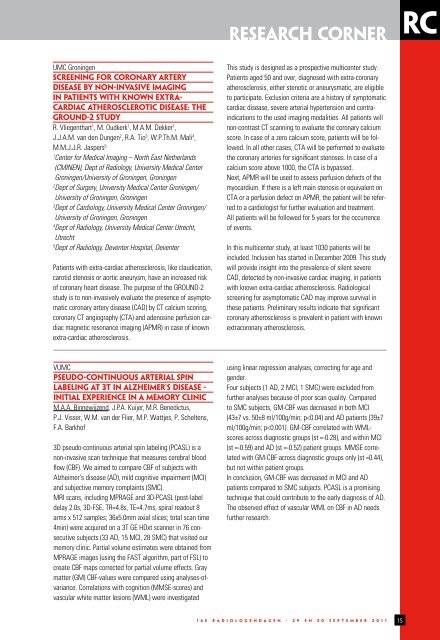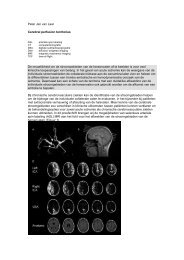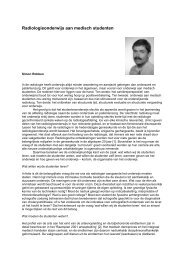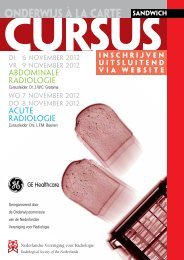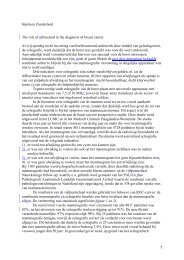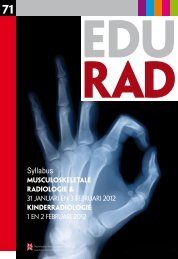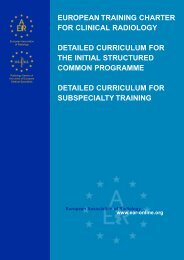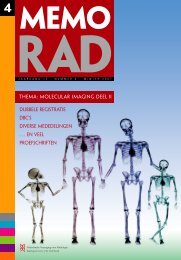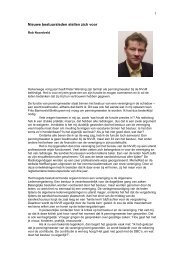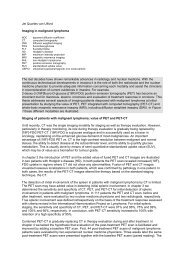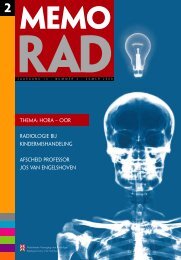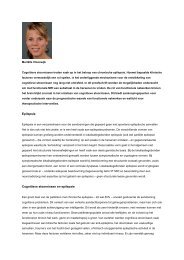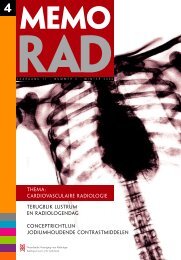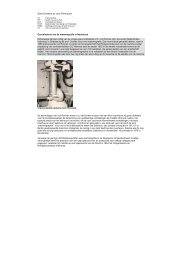programma & abstracts - Nederlandse Vereniging voor Radiologie
programma & abstracts - Nederlandse Vereniging voor Radiologie
programma & abstracts - Nederlandse Vereniging voor Radiologie
You also want an ePaper? Increase the reach of your titles
YUMPU automatically turns print PDFs into web optimized ePapers that Google loves.
RC<br />
research naam corner sessie 1<br />
UMC Groningen<br />
SCREENING FOR CORONARY ARTERY<br />
DISEASE BY NON-INVASIVE IMAGING<br />
IN PATIENTS WITH KNOWN EXTRA-<br />
CARDIAC ATHEROSCLEROTIC DISEASE: THE<br />
GROUND-2 STUDY<br />
R. Vliegenthart 1 , M. Oudkerk 1 , M.A.M. Dekker 1 ,<br />
J.J.A.M. van den Dungen 2 , R.A. Tio 3 , W.P.Th.M. Mali 4 ,<br />
M.M.J.J.R. Jaspers 5<br />
1<br />
Center for Medical Imaging – North East Netherlands<br />
(CMINEN), Dept of Radiology, University Medical Center<br />
Groningen/University of Groningen, Groningen<br />
2<br />
Dept of Surgery, University Medical Center Groningen/<br />
University of Groningen, Groningen<br />
3<br />
Dept of Cardiology, University Medical Center Groningen/<br />
University of Groningen, Groningen<br />
4<br />
Dept of Radiology, University Medical Center Utrecht,<br />
Utrecht<br />
5<br />
Dept of Radiology, Deventer Hospital, Deventer<br />
Patients with extra-cardiac atherosclerosis, like claudication,<br />
carotid stenosis or aortic aneurysm, have an increased risk<br />
of coronary heart disease. The purpose of the GROUND-2<br />
study is to non-invasively evaluate the presence of asymptomatic<br />
coronary artery disease (CAD) by CT calcium scoring,<br />
coronary CT angiography (CTA) and adenosine perfusion cardiac<br />
magnetic resonance imaging (APMR) in case of known<br />
extra-cardiac atherosclerosis.<br />
This study is designed as a prospective multicenter study.<br />
Patients aged 50 and over, diagnosed with extra-coronary<br />
atherosclerosis, either stenotic or aneurysmatic, are eligible<br />
to participate. Exclusion criteria are a history of symptomatic<br />
cardiac disease, severe arterial hypertension and contraindications<br />
to the used imaging modalities. All patients will<br />
non-contrast CT scanning to evaluate the coronary calcium<br />
score. In case of a zero calcium score, patients will be followed.<br />
In all other cases, CTA will be performed to evaluate<br />
the coronary arteries for significant stenoses. In case of a<br />
calcium score above 1000, the CTA is bypassed.<br />
Next, APMR will be used to assess perfusion defects of the<br />
myocardium. If there is a left main stenosis or equivalent on<br />
CTA or a perfusion defect on APMR, the patient will be referred<br />
to a cardiologist for further evaluation and treatment.<br />
All patients will be followed for 5 years for the occurrence<br />
of events.<br />
In this multicenter study, at least 1030 patients will be<br />
included. Inclusion has started in December 2009. This study<br />
will provide insight into the prevalence of silent severe<br />
CAD, detected by non-invasive cardiac imaging, in patients<br />
with known extra-cardiac atherosclerosis. Radiological<br />
screening for asymptomatic CAD may improve survival in<br />
these patients. Preliminary results indicate that significant<br />
coronary atherosclerosis is prevalent in patient with known<br />
extracoronary atherosclerosis.<br />
VUMC<br />
PSEUDO-CONTINUOUS ARTERIAL SPIN<br />
LABELING AT 3T IN ALZHEIMER’S DISEASE -<br />
INITIAL EXPERIENCE IN A MEMORY CLINIC<br />
M.A.A. Binnewijzend, J.P.A. Kuijer, M.R. Benedictus,<br />
P.J. Visser, W.M. van der Flier, M.P. Wattjes, P. Scheltens,<br />
F.A. Barkhof<br />
3D pseudo-continuous arterial spin labeling (PCASL) is a<br />
non-invasive scan technique that measures cerebral blood<br />
flow (CBF). We aimed to compare CBF of subjects with<br />
Alzheimer’s disease (AD), mild cognitive impairment (MCI)<br />
and subjective memory complaints (SMC).<br />
MRI scans, including MPRAGE and 3D-PCASL (post-label<br />
delay 2.0s, 3D-FSE, TR=4.8s, TE=4.7ms, spiral readout 8<br />
arms x 512 samples; 36x5.0mm axial slices; total scan time<br />
4min) were acquired on a 3T GE HDxt scanner in 76 consecutive<br />
subjects (33 AD, 15 MCI, 28 SMC) that visited our<br />
memory clinic. Partial volume estimates were obtained from<br />
MPRAGE images (using the FAST algorithm, part of FSL) to<br />
create CBF maps corrected for partial volume effects. Gray<br />
matter (GM) CBF-values were compared using analyses-ofvariance.<br />
Correlations with cognition (MMSE-scores) and<br />
vascular white matter lesions (WML) were investigated<br />
using linear regression analyses, correcting for age and<br />
gender.<br />
Four subjects (1 AD, 2 MCI, 1 SMC) were excluded from<br />
further analyses because of poor scan quality. Compared<br />
to SMC subjects, GM-CBF was decreased in both MCI<br />
(43±7 vs. 50±8 ml/100g/min; p


